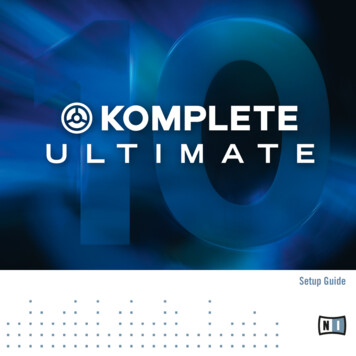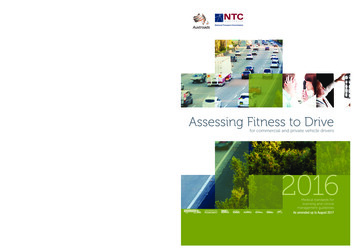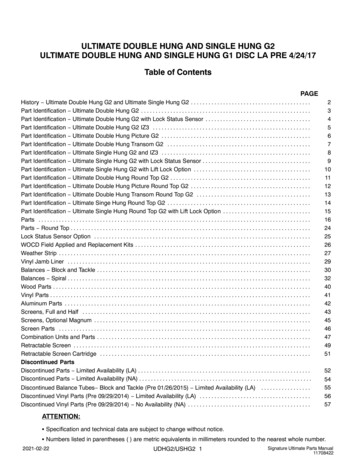
Transcription
The Ultimate Guideto Assessing Sales RepCompetency
Table of ContentsIntroduction . . . . . . . . . . . . . . . . . . . . . . 3The State of Sales Competency . . . . . . . . . . . 5The Future of Sales Competency . . . . . . . . . 19Methodology . . . . . . . . . . . . . . . . . . . . . 23About Allego’s Sales Learning Platform . . . . . .25The Ultimate Guide to Assessing Sales Rep Competency 2
Does this story sound familiar? You’re the head of sales and it’s the end ofquarter. You find yourself relying on a few “rock stars” to hit the numbers.The rock stars, along with a few lackluster sales reps, somehow pull out thebiggest deals on the last day of the quarter.And so, you hold on to mediocre reps and hope that the rock stars will carrythe team. The result: massive uncertainty as every quarter winds down witha few deals resting on a handful of sales reps who will make or break thenumber. In other words—uncertainty.We set out to find out how to pave a better path and find the recipe toreduce the uncertainty in the sales process. Proactive leaders want to knowwhich reps need help before it impacts the business’s revenue. They strive toreduce the risk of missing quota and create highly competent sales teams.In this study, we go beyond the lagging indicator of quota achievementto uncover the metrics that sales leaders should use to assess salescompetency and create highly functioning, winning teams. These resultsshow the practical yet achievable best practices that speed on-boarding,encourage frequent coaching and provide sales reps with the individualattention they need to succeed.It’s time to ensure you are on the path to moving your “B” and “C”players to “A” players. Here’s how:The Ultimate Guide to Assessing Sales Rep Competency 3
Sales Competency: the One Factor That Is Botha Leading Indicator and under Your ControlIt’s the ONE FACTORthat’s both a leadingindicator AND underyour control.Let’s start by asking why this topic matters. Sales leadersare busy. Why bother with something as geeky-soundingas assessing sales competency?Simple. It’s the ONE FACTOR that’s both a leading indicatorAND under your control.Your job as a sales leader is to hit the number, consistently,quarter after quarter. Given how critical the number is, salesleaders like you care a great deal about whether or not yourteams are on target. So you invest enormous effort intoforecasting. You measure the amount of sales activity, divedeep into the pipeline and use your sixth sense to uncover iftrouble is brewing.But what can you really do when your pipeline indicatorslook light? By the time trouble shows up, it’s too late to domuch about it. You don’t control your customers’ buyingcycles. At most, you can try to accelerate buying cyclesunnaturally, usually by dropping the price.There is another “leading indicator”. It’s measurable. It’syour team’s proven ability to execute on the disciplinesof sales competency. Competency is the one leadingindicator that predicts your team’s future ability to hitthe number,well in advance of the current quarter. And, it’sfully under your control. That’s why it’s worth assessingthe competency of your team.The Ultimate Guide to Assessing Sales Rep Competency 4
The Stateof SalesCompetencyThe Ultimate Guide to Assessing Sales Rep Competency 5
Ramp Times by IndustryRamp Times by Product ComplexityWe asked respondents to define how fast they ramp a new hire to a fullquota-bearing rep. Overall, 54% fully ramp their new sales reps in less than 6months. But this varies by industry: Hospitality ramps the fastest with 100%of their reps ramping in less than 6 months. Life Sciences sales teams ramp82% in 6 months. Only 32% of High Tech companies ramp their sales reps inless than 6 months.We also broke this out by complexity. Not surprisingly, reps selling morecomplex products take longer to ramp. But even for complex products,45% of the teams were able to ramp their sales reps in less than 6 months.Industry % in 6 months or lessComplexity0%% in 20%6 monthsless40% or ufacturingCompanies with complex productdecrease ramp time by 20% by hiringreps with previous industry knowledge.43%Financial Services32%High techHealthcareMore Complex70%Business ServicesLess ComplexAverage82%Life ScienceOne difference we noticed amongst the high performing firms with complexproducts: Those that hire reps with industry knowledge claim a 20% fasterramp time.14%0%20%40%6 0%80%100%The Ultimate Guide to Assessing Sales Rep Competency 6
Most Effective Way To Ramp SalesWhen it comes to the best approaches to ramping new salespeople,in-person, one-on-one mentoring from the sales person’s direct managerand coaching on sales calls works best according to our panel.Sales leaders that achieve the fastest ramp time put 12% more emphasison manager mentoring as the primary way to train and ramp new salesteams. They also commented that mentoring wasn’t a once and doneproposition; mentoring should be done continuously.On a 1-5 scale, rank the effectiveness of thefollowing mechanisms used to ramp salespeople.Put more emphasis onmanager mentoring, withcontinual effort, to achievefaster ramp time.The Ultimate Guide to Assessing Sales Rep Competency 7
High performers put at least 10% less emphasis onboot camps, dropping it to less than 17% of the focusand they put more emphasis on peer and mentoringadding 15% more to their focus on peer and 20%more to their focus on mentoring.Sales Training ApproachesCommonly UsedWhen we asked sales leaders which approachesthey use for sales training, sales leader coachingcame out as the most popular.Most focus on sales leader coaching. The least usedmechanism is just-in-time training.The percent using each of these tactics broke outthis way: Sales leader coaching 50% Yearly sales meeting (“kickoff”) 44% Quarterly sales meeting 38%Which approaches do you use to deliver sales training to reps?50%More on PeerMore on Mentoring Peer training 36% Sales playbooks 35% Mentor program 34% Sales bootcamp 27%4030 Just-In-Time training 16%The high performance teams in our survey investedmore in peer and mentoring programs and less ontraditional sales bootcamps.20Less emphasison Bootcamp100Sales leadercoachingYearlysale meeting(kickoff)Quarterlysales sbootcampJust In TimetrainingThe Ultimate Guide to Assessing Sales Rep Competency 8
Consider New Approaches to TrainingWhile only 16% of respondents have adopted the newer approach of “JustIn-Time” training, the latest trends in training show that it is one of the moreeffective approaches to adult learning.“Just-In-Time Training” is an alternative to the traditional approach of “just-incase” training, in which reps try to learn everything they might need to know,including edge scenarios most won’t face, ”just in case” they do. Instead,formal classroom training focuses on the 20% reps will use continuously andprovides the other 80% as “micro-learning” assets, like 3-minute videos, forreps to access and learn only if and when they actually need it.Think about YouTube, for which a common use is learning how to dosomething quickly, or as a reminder of intricate details that may be neededonly rarely. This concept of just-in-time micro learning is a powerfulapproach that more organizations would benefit from adopting.More companies should considerusing just-in-time micro learningtraining to support their repsknowledge.The Ultimate Guide to Assessing Sales Rep Competency 9
1 Coach “constant feedback” “invest your time” “set goals, explain them, live them” “constant one-on-one feedback”Sales Training Approaches Commonly Used “mentor: day in, day out”We asked sales leaders how they created “A” playerswith an open-ended question. Their replies mostly fellinto three buckets.Second, focus on training so that you your reps knowthe product inside out. As one respondent mentioned,make sure they know the product cold. “effective, focused, consistent practice”First, make sure you have top-notch coaching includingconsistent and constant feedback to the sales rep,clear goals, and proactive and constant mentoring.And third, focus on hiring. Some believe you can’t hire“A” players because “good sales people aren’t made;they are born.” “be proactive”2 Train “weekly meetings focus on product training” “training, training, more training” “train them to work on and solve customer needs” “know the product cold” “train until confident; confidence yields competency”45%Coach22%Train3 Hire “hire “A” players to start” “hire from industry”Hire “hire good people and minimize disruptions”15%0%5%10%15% “most sales people aren’t made; they are born”20%25%30%35%40%45%The Ultimate Guide to Assessing Sales Rep Competency 10
Which Skills Define Sales Competency?Now to the heart of the matter: We asked respondentsto rate which skills are most important for definingsales competency. We used a scale of 1-5, 5 beingmost important.Given this focus on product knowledge, you shouldask yourself: Do you certify your reps on their productknowledge? Are you keeping them up to date onproduct changes? Can they easily call out your productdifferentiation?47% indicated product knowledge was the mostimportant feature and ranked it a 5. Sales leaders ratedinterpersonal and operational selling skills as the secondmost important (just behind product knowledge).High-performing companies focus even more onproduct knowledge—saying that it was the number oneway at 65% of their focus.Which skills are most important to define a sales persons competency?0%65% of high performingcompanies rated productknowledge as the mostimportant skill to measuresales competency.5%10%15%20%25%30%35%50%46%Interpersonal SkillsOperational selling36%18%Selling Process AdherenceLeadership Skills4 5%47%Product KnowledgeCompetitor Awareness4 0%13%10%The Ultimate Guide to Assessing Sales Rep Competency 11
Which Sales Skills Do Managers Assess?Next, we drilled into selling skills more granularly.We looked at the 8 key aspects of salescompetency including sales planning, prospecting,qualifying pipeline, pitching to prospects,negotiating contracts, closing deals, managingcustomers, and retaining customers.Across all respondents, closing (70%) andprospecting (69%) were the most importantareas of sales competency to measure. Only53% of respondents indicated that ability to pitchthe solution was an important competency tomeasure.Of course, building pipeline and closing deals areimportant aspects of the sales role. But the storychanges when you evaluate high-performingcompanies.For which of the following skills do you assess your reps?Ability to close70%Ability to prospect new opportunities69%59%Ability to retain existing clientsAbility to pitch solution53%Ability to qualify new deals52%Ability to negotiate50%Ability to plan strategically50%Effective time management46%The Ultimate Guide to Assessing Sales Rep Competency 12
Top Performers Focus on Sales MessagingHigh-performing companies had a dramaticallydifferent view on how to asses sales competency.They believe a sales rep’s sales messaging –the ability to pitch the solution – is the mostimportant sales competency to measure. 80% ofhigh-performing companies assess their reps onpitching versus only 53% of the general population.High-performing companies indicate that pitchingthe product, with a focus on the product aspectsthat deliver on the buyers needs, and the salesperson’s ability to quickly discern what is importantto the buyer, create a winning combination anddrive high quota achievement. These organizationsalso put more emphasis on prospecting newopportunities than the general population ofrespondents.For which of the following skills do you assess your reps?Ability to pitch solution80%Ability to prospect new opportunities75%Ability to retain existing clientsAbility to negotiate63%59%Ability to close56%Ability to plan strategically56%Effective time management56%Ability to qualify new deals 44%The Ultimate Guide to Assessing Sales Rep Competency 13
What: High Performers Assess Additional CompetenciesHigh-performing companies added that, in addition to the competencies we asked about, they focus on other areas as well:Communication skillsCustomer feedbackProblem solvingThese companies indicated that they arelooking for people that “communicateclearly and articulately”.High performers ask customers abouttheir sales person’s ability to sell, pitch andmaintain healthy relationships.The ability to solve, or lead others tosolve, complications that arise during andafter the sales process.The Ultimate Guide to Assessing Sales Rep Competency 14
Determine Sales CompetencyYou know the saying, “you have to see it to believe it”. It rings true forsales leaders as well. The most popular mechanism used to assesa sales person’s competency is “live ride-alongs”. Our sales leadersindicated that seeing the sales person in action is the best way todetermine their overall competency. This also aligns with the highrating given to the importance of interpersonal skills and selling skills inmeasuring sales competency.Activity tracking, like measuring the number of interactions with clients,number of meetings, and other industry-specific activities, is thesecond most common way to assess competency. Today’s customerrelationship management tools, like Salesforce, make measuring thesemetrics easy.Our survey found significant differences across industries in the meansused to assess sales competency. 100% of Life Sciences sales leaders use ride-alongs, compared tojust 68% of the general population. This stems, at least in part, fromthe regulation and compliance risks faced by Life Sciences salesteams. 80% of High Tech sales teams use activity tracking to measurecompetency compared to 61% of the general population. This islikely due to High Tech companies’ adoption of technologies thatmake it easy to monitor sales activities. 60% of Healthcare services organizations use this call recordingto assess competency whereas only 18% of the full panel ofrespondents reported using call recordings.Which tools do you use to assess sales competency?68%Live ride-alongs61%Activity tracking46%Peer feedbackRole playing43%33%Formal certification22%Quizzes18%Call recording13%Video recording7%Other0%10%20%30%40%50%60%Industry Differences in Sales Competency Assessment100%80%60%Ride-Alongin Life SciencesActivity Trackingin High TechCall Recordingin HealthcareThe Ultimate Guide to Assessing Sales Rep Competency 1570%
When Do Managers Assess Their Teams?We asked how often sales leaders are measuring their sales reps’ performance. 70% ofrespondents say they measure it regularly, in an ongoing fashion, with the balance (30%)only measuring quarterly or less. High performers assess sales team competency morefrequently: 85% focus on continuously measuring sales.How often do you measure sales teams’ performance?85% of high performersmeasures sales teamperformance weeklyor 3%1%0%5%10%15%20%25%30%35%40%The Ultimate Guide to Assessing Sales Rep Competency 16
Handling Competency GapsFinally, let’s look at how sales leaders handle gaps in salesperson competency. Thegood old “PIP”, Performance Improvement Plans, is the by far the most popular way todeal with sales rep competency gaps. But what does a PIP really accomplish other thanspurring the rep to revamp their resume?In contrast, high performers reduce their focus on performance improvement plans andlean into training reps who have competency gaps. They respond with training 3 timesmore frequently.What action do you take when assessment indicates competency gaps?High performersaddress competencygaps with training3x more.Implement performanceimprovement plans50%Increased focus frommanagement31%15%Increased trainingRelease (firing) of salesrepMore Training3%Other, please list: 2%0%5%10%15%20%25%30%35%40%45%5 0%The Ultimate Guide to Assessing Sales Rep Competency 17
Key TakeawaysFrom High Performance TeamsWe found five important takeaways from this data.1Companies that use manager coaching to train sales repsalso ramp the sales reps to full quota-bearing faster.2 High performance teams put less training effort into bootcamps and more into peer and manager coaching.3 When it comes to the specific skills they ensure repspossess, top performers focus on sales messaging—theability to pitch the solution, with an emphasis on knowingthe product and how it delivers value.4 High performance teams measure performance andassess competency more frequently and continuously.5 When they find competency gaps, the best salesteams respond not just with a PIP, but with training thataddresses those gaps.The Ultimate Guide to Assessing Sales Rep Competency 18
The Futureof SalesCompetencyAssessmentThe Ultimate Guide to Assessing Sales Rep Competency 19
Where Do We Go From Here?We asked where companies will take their sales competency assessment inthe future. Most organizations (fully 53% of respondents) believe they shouldexpand their assessment of sales competency. 38% plan to add activitytracking and will focus on using the technology they have in place to get anaccurate and frequent picture of their sales teams competency. 27% plan toadd role-playing to their assessment of sales peoples’ competencies.In the future, how do you see your assessmentof sales competency changing?You intent to cut back assessmentIn the future, how do you see your assessmentof sales competency changing?38%Activity tracking2%27%Role playing26%Live ride-alongsFormal certificationYou will keep at currentlevel45%25%Peer feedback53%You will expandassessment24%22%Video recording17%Other13%Quizzes12%Call recording0%5%10%15%20%25%30%35%The Ultimate Guide to Assessing Sales Rep Competency 2040%
Barriers to Assessing Sales CompetencyWhile the majority of sales leaders plan to conductmore sales competency assessments in the future,they’ll have to overcome several barriers to do so. Alack of leadership time and lack of systematic metricsare the two big ones.34% of companies say that lack of metric-basedfacts also hinder their ability to assess sales peoples’competency. We see that critical training andassessment activities are handled in-person todayusing less quantifiable means like manager coachingand ride-alongs. So organizations will have to overcomethese barriers by using technology that enablesmeasurement of competency.This “lack of leadership time” conflicts directly withthe specific training and assessment activities thatdistinguish high performers: mentoring new salespeople, coaching reps, going on ride-alongs, etc. That’swhere technology can help.OtherWhat prevents you frommore thoroughly assessingsales rep competency?15%Lack offocus38%13%Lack ofsystematic metricsLack ofleadershiptime34%The Ultimate Guide to Assessing Sales Rep Competency 21
Overcome Barriers to Sales SuccessUntil very recently, the words “training” and “innovation”haven’t been used together to refer to mostorganizations’ sales onboarding and competency. Fordecades, sales leaders have used tactics that includetime intensive ride-alongs, firehose learning of the salesbootcamp, and expensive yearly sales meetings. Whenthese fail to produce the right results, reps are put onperformance improvement plans. This is not the recipeto turn your “B” and “C” players into “A” players.Today, with modern technology, you have theopportunity to do better. You can use mobile devices,video, peer-to-peer mentoring and just-in-time microlearning to change the game.Combining innovative technology with your focuson improving sales competency creates newopportunities: Enable reps to practice their pitch using anydevice to record their progress. They can sharerecordings with managers and trainers forreview, and once they get it down pat, becomecertified. Managers can review the reps’progress, wherever and whenever they like, evenon an airplane, breaking the requirement thatreps and managers be in the same place at thesame time to get coaching and feedback. Foster a culture of peer-to-peer training as a wayto overcome that “lack of management time”barrier. It’s a force multiplier. Our past surveyshows that salespeople like learning from theirpeers more than from trainers or those that aren’tin the field day-to-day. Make it easy for reps to train and improve theircompetency by enabling them to spot bestpractices from reps across the globe. When it iseasy to uncover best practices and collaboratewith the best performers, reps will implementbest practices swiftly. Measure competencydigitally with a record of feedback provided toeach rep. Make it easy to score a reps’ pitches,and provide insight into skill and knowledgemastery. Move from the old episodic, in-person, “just-incase” model to a constantly on, micro-learning,just-in-time model. This less disruptive and lesscostly approach provides repetition and enablesmanagers to focus on training gaps.Every company wants to create a high performingsales team. We’ve uncovered the model thatpromotes learning programs that will create highlycompetent sales reps and creates an environmentthat breeds “A” players.The Ultimate Guide to Assessing Sales Rep Competency 22
The Methodologyand StudyUsing a research firm called Research Now, we surveyed 150 sales execsand sales enablement VPs about their sales teams’ competency metricsand assessment. We asked about their hiring, how they ramp, how fastthey ramp, which approach they used to training and how they assess andmeasure competency.A Look at Our PanelWhile we focused on B2B sales, we set out to ensure we had broadsupport from industries and businesses of varying levels of success.Our data came from differing sectors, including High Tech, FinancialServices and Manufacturing. Where appropriate, this report will highlightthe differences found across industries, but for the most part results aresimilar across each industry.We were able to segment high performance teams from the generalpopulation. Here, we document for you where they differ and what youcan do to mimic their success.The DataOur survey responses came from executiveswith these characteristics: CEO, CRO, SVP/VP of Sales, Sales Director,Sales Enablement Director Large companies with 250 or more employeesthat have large numbers of sales reps Using a B2B sales model 40% rate their product as highly complex(top of those on a scale of 1-10)High tech17%Financial services Insurance17%Manufacturing17%9%Life sciences8%Business services6%Healthcare services7%Other0%2%4%6%8%10%12%14%16%18%The Ultimate Guide to Assessing Sales Rep Competency 23
Comparing Highest Performing Teamsvs. the RestWe also sliced the data by sales team achievement. We defined “highperformers” as those sales teams that achieved 100% or more of their quota inthe last year and those with more than 74% of their sales reps achieving quotain the last year.In the context of onboarding, we defined “high performing” as those thatramped sales teams the fastest.What percentage of your sales reps achievedquota in the last 4 quarters?What is your team’s average quarterly revenueachievement versus goals over the last 4 quarters?Less than 75%2%Less than 25%37%Between 75-99%Average 100%5%10%15%20%25%39%Between 50-74%25%0%14%Between 25-49%35%Consistently over 100%4%43%Greater than 74%30%35%40%0%5%10%15%20%25%30%35%40%45%The Ultimate Guide to Assessing Sales Rep Competency 24
About Allego’s Sales Learning Platform Deliver consistent, proficient messaging Share peer-to-peer best practices Reinforce skills and knowledge in the field Expand coaching opportunities Increase manager accountabilityHarnessing the convenience and power of mobile, video and peer learning, Allego’s sales learning and coaching platformreinvents sales training to help teams accelerate time to competency, accurately deliver on message, confidently handleobjections and effectively articulate value. Enabling better performance for tens of thousands of sales professionals acrosshigh tech, financial services, medical device/life sciences and other industries made Allego the 5th fastest-growing softwarecompany on the 2017 Inc. 500 list.Explore further at www.allego.com.
The Ultimate Guide to Assessing Sales Rep Competency 12 Next, we drilled into selling skills more granularly. We looked at the 8 key aspects of sales competency including sales planning, prospecting, qualifying pipeline, pitching to prospects, negotiating contracts, closing










